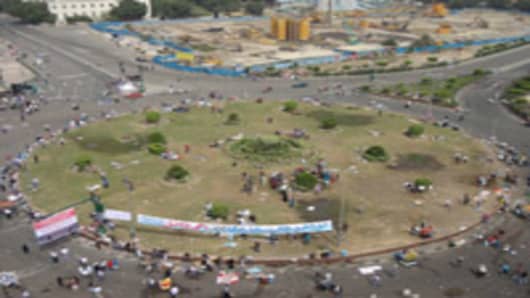It feels strange to be on a flight back to Tahrir Square in downtown Cairo, to cover what’s been dubbed Egypt’s Second Revolution. Yes, the last one, which brought down the regime of former President Hosni Mubarak, was just over three months ago.
At the time, global markets watched in trepidation as one of the perceived cradles of regional security began to crumble while scrambling to find certainty in the wild casino of the ‘Arab Spring’ that is now really getting closer to an ‘Arab Winter’.
In a bid to perhaps decelerate the momentum behind Friday’s protest, the country’s Prime Minister, Essam Sharaf, appeared on State Television to ask Egyptians for more time to meet demands. He did not mention the expected protests, but it came as authorities also gave in to public pressure by placing Mubarak and his two sons on trial for criminal charges, including murder and the abuse of funds.
Egypt, one of two emerging markets in the region of the Middle East and North Africa, has been struggling to recover important sources of revenue, especially tourism and foreign direct investment (FDI) that have fallen since the revolution.
Government officials estimate that some $10-12 billion in financing need to be bridged by mid next year. Although rubber bullets and tear gas no longer dominate the scene at the historic downtown square, a crime wave has ensued in the absence of sufficient security forces; a development widely acknowledged as an impediment to the economic recovery.
According to Al-Ahram newspaper, around 40 parties and movements expressed their intention to participate in the protest, while 12, including the sizable Muslim Brotherhood and the Salafists, will not join the rally. There continues to be widespread discussions for and against the demonstrations on popular social networking sites like Twitter and Facebook.
Protestors are growing frustrated by the slow pace of political and economic reform in the most populous Arab nation. They are demanding from the ruling Supreme Council of the Armed Forces (SCAF), among other points, a civilian government, faster trials of former regime officials and a new constitution. Many Egyptians, grappling with rising food prices and unemployment, feel that the SCAF has mishandled the transition thus far, and are sceptical of what’s to come.
The army has said it will avoid locations of planned protests and “rely on the youth of the great revolution to handle organization and security”. Meanwhile, reports emerged that several activists have been arrested.
To the surprise of several analysts, the local stock market (EGX30) extended gains on its last trading day of the week on Thursday, buoyed by the prospect of additional aid from the G8 following similar pledges from the United States, Saudi Arabia and the World Bank.
Prime Minister Sharaf is expected to attend the G8 summit in France on Friday as part of an Egyptian delegation to garner support. The United States earlier called on the G8 to consider debt swaps for Egypt that would allow debt payments to be channeled towards underwriting "swift, sustainable job creation".
The Market Vectors Egypt ETF performance later on Thursday will reveal more about investor sentiment ahead of the ‘Friday of Anger’. Most analysts continue to believe that Egypt remains an attractive destination for medium to long-term players. If there is a political volatility benchmark for post-revolutionary periods, it would be quite the graph. The EGX, as the worst performing emerging market this year, can bear witness to that.


